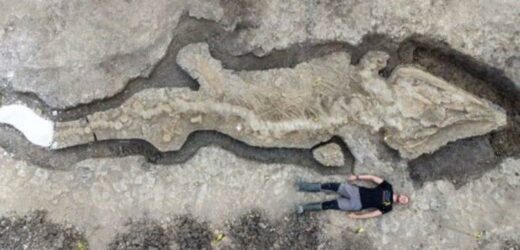Tyrannosaurus rex: Expert examines brain of dinosaur
We use your sign-up to provide content in ways you’ve consented to and to improve our understanding of you. This may include adverts from us and 3rd parties based on our understanding. You can unsubscribe at any time. More info
The 33ft (10m) long ichthyosaur skeleton is around 180 million years old and is thought to be the largest UK example of a predator which roamed the seas when dinosaurs were around. And The block containing the 6ft (2m) skull and surrounding clay weighed a tonne alone. Dubbed “sea dragons”, the reptiles were similar in shape to dolphins but varied in size from 3 – 82ft (1 – 25m). It was discovered at Rutland Water Nature Reserve.
Not only is this the biggest dinosaur fossil ever found in Britain, but it is also the most complete skeleton of its kind found in the UK.
It is also believed to be the first ichthyosaur of its specific species (Temnodontosaurus trigonodon) found on British soil.
Anglian Water, which owns the area, said it is now looking for funding to protect and display the bones close by.
Joe Davis, conservation team leader at Leicestershire and Rutland Wildlife Trust, stumbled upon the spectacular beast during a routine draining of a lagoon island for re-landscaping back in February 2021.
Mr Davis said: “The find has been absolutely fascinating and a real career highlight.


“It’s great to learn so much from the discovery and to think this amazing creature was once swimming in seas above us.
“Now, once again, Rutland Water is a haven for wetland wildlife albeit on a smaller scale.”
The head of the excavation team was palaeontologist Dr Dean Lomax.
He has studied thousands of ichthyosaurs over his career.
He said: “It was an honour to lead the excavation.

“Britain is the birthplace of ichthyosaurs – their fossils have been unearthed here for over 200 years.
“Despite the many ichthyosaur fossils found in Britain, it is remarkable to think the Rutland ichthyosaur is the largest skeleton ever found in the UK.
“It is a truly unprecedented discovery and one of the greatest finds in British palaeontological history.”
Now, palaeontologists will continue to carry out research and work on the conservation of the discovery.
Academic papers are due to be published in the future.
The remains were fully excavated earlier this year and will feature on BBC Two’s Digging for Britain, which will air on Tuesday.
Ichthyosaurs first appeared around 250 million years ago and went extinct 90 million years ago.
DON’T MISS
Yellowstone supervolcano warning after magma chamber discovery [REPORT]
NO fourth Covid vaccine needed as new booster guidance given [INSIGHT]
Mystery bite mark on Great White Shark sparks Megalodon theory [REVEAL]


While the recent discovery was the biggest ever found, it was not the first to be made at Rutland Water.
Back in the 1970s, two incomplete and much smaller ichthyosaurs were found when the reservoir was initially constructed.
But the giant Rutland sea dragon is not the only exciting find of an extinct creature that has been unearthed recently.
Back in December, a couple hunting for marine fossils in Wiltshire came across the remains of “mammoth graveyard.”
In total, the remains of five mammoths – two adults, two juveniles and an infant were unearthed.
Sally Hollingworth, who came across the remains with her husband Neville, said: “We started digging and realised it was the leg bone of a mammoth.
“It’s still a goosebump moment now, I can still remember the feeling I had.”
Source: Read Full Article


